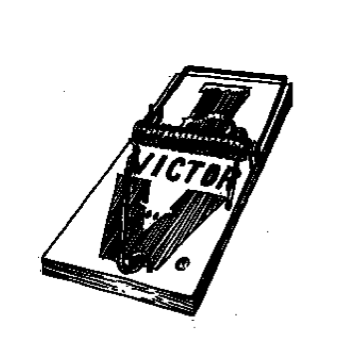Humans kill rats with poisons named after helicopters: Talon, D-Con II, Enforcer, Havoc, Jaguar, Boothill, Hawk, Tomcat, Top Gun, Assault. Either that, or the tools of military punishment so often take their shapes and sobriquets from predators that it becomes a circular question. Which came first, the Pentagon or the exterminator? In the case of our oldest modern rodent-killer, the chemical compound itself is called warfarin. U.S. scientists designed warfarin in Wisconsin three years after the U.S. government dropped a nuclear bomb on Hiroshima. To me, this seems less an accident than a symptom of the culture of existential disposability that plagues modern life yet only dependably reveals its theoretical core when we speak of rats. The core being this: life matters, but there are different levels of life, worth different amounts.
By 1950, gloomy philosophy had found its peacetime footprint in killer product. Most rodenticides, as they’re called, are anticoagulants: they incapacitate a rodent while its lungs fill with blood. Other unfortunates are smashed with brooms and bricks, snapped into traps that crack their spines, glued to cards where they starve to death, or simply tested on, gene-spliced, or done up in poisonous make up that eats away their flesh. In nineteenth-century New York, entrepreneurs made gloves out of them.
But who would be fool enough to advocate for these most scorned mammals? At least history gave the bat its vampire cult. No one suspects the rodent of some covert erotic transformation. The mouse is dirty. The mouse eats trash. It invades the sanctity of the white-walled home with a disturbing grayness. A rat is worse. A rat lives in the city. Bearer of disease, the rat nurses its young with milk and slops around on the subway tracks, switching its naked pink tail. And a rat bites. At least a mouse has the deference not to defend itself.
Yet there is something that gnaws about the rodent. Perhaps it’s the cast of its fearful eye or, alternately, its fearlessness, its brazen self-assertion in the face of our clearly superior force. The rodent has a will that can be respected. It persists in living despite its scrappy fragility and our preference that it didn’t. Its mute single-mindedness, its noble anonymous striving, its inability to sleep through the night—all these are familiar qualities. A suspicion arises that deep in our cantankerous mammalistic core, the rodent and the human are one.
In real life, the hysteria of the rodent encounter buries this link—the rodent in the dark alley, the rodent in the rafters, the rodent in the weeds. After a steady dose of the warfarin of rhetoric, one couldn’t be blamed for thinking There are two sides. The...
You have reached your article limit
Sign up for a digital subscription and continue reading all new issues, plus our entire archives, for just $1.50/month.
Already a subscriber? Sign in





